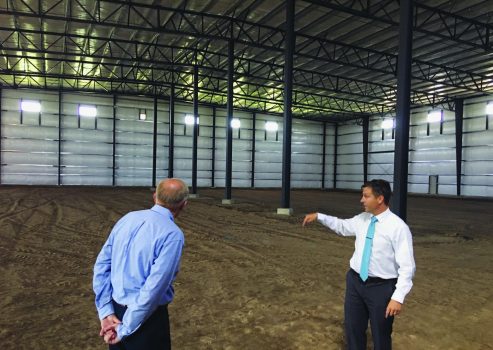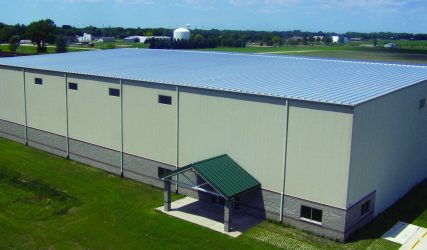
in Slater, hollow so they can be quickly finished to the specifications
of a particular tenant.
A 40,000-square-foot building on a nine-acre industrial site in eastern Spencer, Iowa, has become the testing ground for a new initiative in rural economic development—with CIRAS playing a large role.
Spencer city manager Bob Fagen said the speculative building, part of a large, new industrial park that city leaders broke ground on in 2009, was constructed along a rail line with 35-foot-high walls because Spencer officials hoped it would prove attractive to a company making equipment for Iowa’s growing wind and solar power industries.
Since construction, businesses from a variety of industries have shown glimmers of interest in the facility, Fagen said, although no purchaser has yet materialized. Now, Spencer officials and the people who helped them build the building in the first place have hit on a possible new way to woo an outside manufacturer to town.
“The idea is that when we market our building to ‘ACME Corporation,’ if that company says they’re not sure this building will work, then we can say, ‘Well, let us connect you with CIRAS at Iowa State University, and they can help us work through these challenges,” said Kiley Miller, president and CEO of the Iowa Lakes Corridor Development Corporation, a regional economic development group that includes Spencer.
“Historically, we’ve referred business to CIRAS many times over the years, but always they were existing employers in the region,” Miller said. “This is a new opportunity for us to use CIRAS as a business-attraction partner.”
Spencer’s building is one of 75 speculative industrial structures that have been constructed over the past 30 years under partnerships involving rural Iowa communities, their local utilities, and the Iowa Area Development Group (IADG). Sixty-five of those buildings—all but the most recently constructed— now belong to viable Iowa businesses, ranging from food processors to a tire company and a maker of medical devices.
“This is a common tool,” said IADG president Rand Fisher. “It’s simply one of our strategies that we use to grow industries in Iowa.”
Founded in 1985, IADG works with rural utility companies in Iowa to invest in their communities in a variety of ways. The organization uses a special grant program from the U.S. Department of Agriculture (USDA) to provide seed money for rural development projects, including the speculative buildings. Local utilities, businesses, and/or governments typically finance construction costs, with assistance from IADG-obtained grants as the final piece.
“Research suggests that 80 percent or more of economic development projects start with a search for an existing facility,” Fisher said. “If a company wants to go somewhere, they want it to be as convenient as possible.”
In 2015, when IADG received a special national award from the USDA, federal officials credited the agency with using $82 million in USDA grant money to leverage $635 million of capital investment on more than 200 Iowa projects of various types. Those projects led to the creation of 15,000 rural Iowa jobs and establishment of nearly 50 revolving loan funds for rural businesses and organizations to access across the state.

Fagen and Fisher describe speculative buildings as just another part of planning ahead for development in small-town Iowa. Spec or “shell” buildings generally are left unfinished, with dirt floors that can quickly be completed to whatever specification a new owner requires.
According to Fisher, IADG’s sponsors have been involved in construction projects ranging from “10,000 to 50,000 square feet and larger” in a list of communities that includes Spirit Lake, Iowa Falls, Hampton, Harlan, and Mount Pleasant, among others.
“The aspirational goal of most of these communities when they build a spec building is to recruit an industry that could become an economic engine for their community,” Fisher said.
CIRAS director Ron Cox said the initiative makes sense because IADG and its partners essentially are playing the role of investors and developers.
“The argument for it is that in large metropolitan areas, there’s enough competition and enough companies coming and going that real estate people will speculate and build these buildings themselves—because they know that they’re going to be able to rent them,” Cox said. “In rural areas, there’s not enough competition for the space, so fewer people want to risk building these.”
Cox said CIRAS also sees broader possibilities in a pilot project involving the Spencer building.
CIRAS, which was created in 1963 as an outreach arm of the Iowa State University College of Engineering, traditionally has focused most of its efforts on making existing businesses (and, by extension, their communities) function better, Cox said. CIRAS currently offers a variety of programs designed to help Iowa companies boost growth, increase productivity, embrace new technology, and enhance their enterprise leadership.
The newly expanded relationship with IADG, Cox said, will allow CIRAS to broaden that role by assisting in the recruitment of new companies to Iowa and/or the expansion of existing Iowa companies.
Many details of the pilot project remain to be worked out. CIRAS will start by helping circulate word about the vacant building during conversations with its industrial clients, as well as by helping educate potential purchasers about the Iowa resources available to help a company get up to speed faster. Additional CIRAS aid might or might not be added later to an economic incentive program for a potential purchaser, depending on that company’s need.
Cox stressed that CIRAS will only be a part of deals that involve a firm that is new to Iowa or one looking to expand by adding a second facility. Helping a company move from one Iowa community to another would fall outside the center’s mission, he said.
Fisher said he hopes IADG’s new relationship with CIRAS will help educate more Iowa manufacturers that “there are options like this in their backyards.”
> For more information about the Spencer building, contact Kiley Miller at kmiller@lakescorridor.com or 712-264-3474. To see a list of speculative buildings available across Iowa, visit http://bit.ly/2hVHc1P or call the IADG at 800-888-4743.
A version of this article was published in the Winter 2017 edition of CIRAS News. To read more of that edition or others, please explore elsewhere on our website.